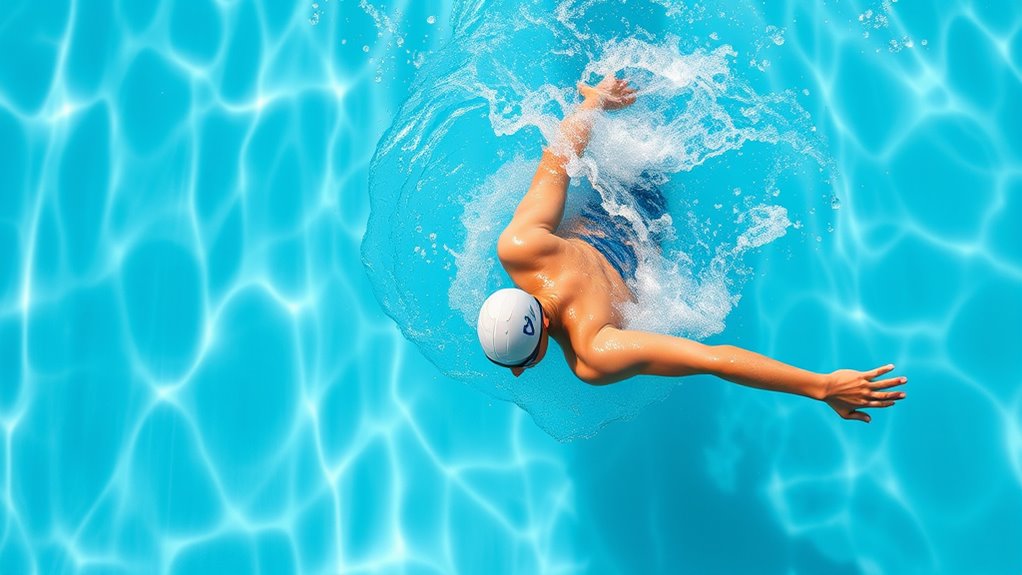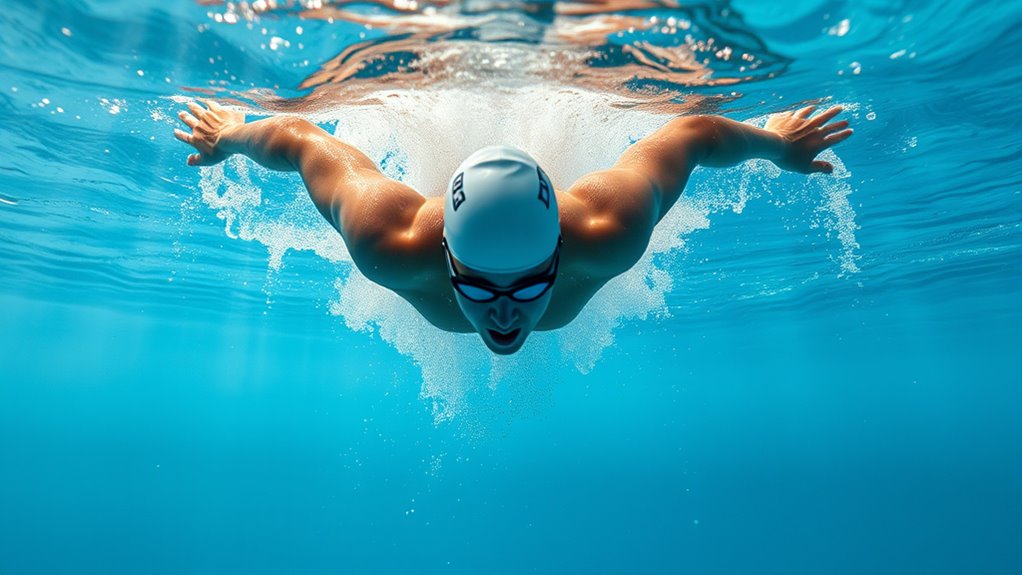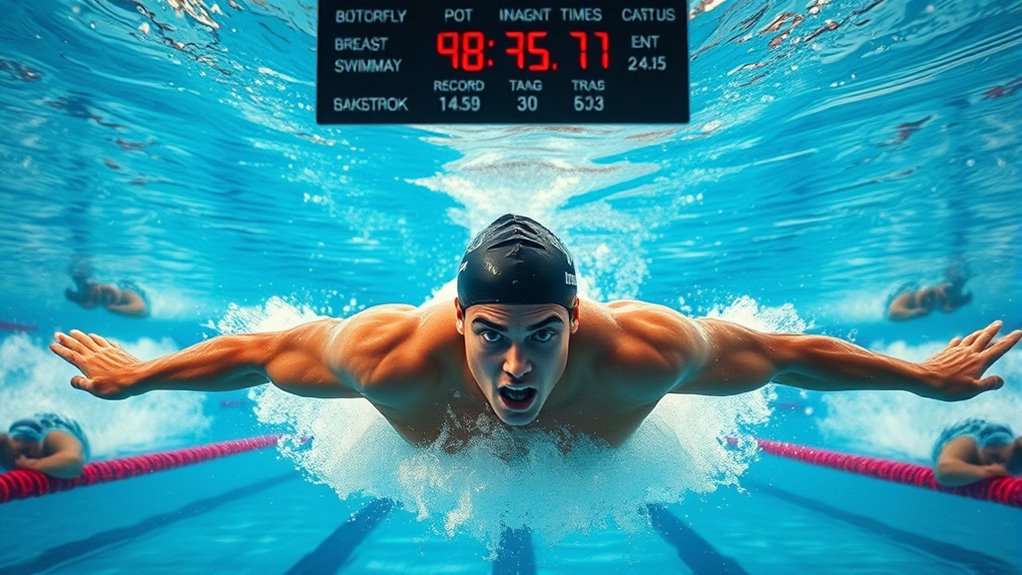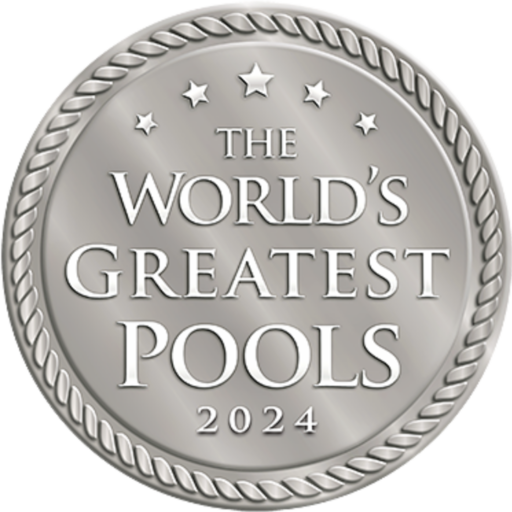Freestyle is the fastest swimming stroke because it combines ideal hydrodynamics with continuous propulsion. You’ll encounter less water resistance due to your horizontal body position, which minimizes frontal drag by 20-30%. The alternating arm movement provides uninterrupted forward momentum while your streamlined profile creates minimal disturbance in the water. Your flutter kick stabilizes without creating excessive drag. These mechanics give freestyle the highest propulsion-to-resistance ratio among all competitive strokes. The technical elements behind this efficiency reveal swimming’s perfect physics formula.
The Science of Streamlining: How Freestyle Minimizes Water Resistance

While moving through water, your body encounters approximately 800 times more resistance than in air, making hydrodynamics essential to freestyle efficiency. Your horizontal body position creates a streamlined profile that minimizes frontal drag as you cut through the water. This alignment—with hips and legs near the surface—reduces the cross-sectional area disrupting water flow.
The alternating arm recovery above water eliminates the drag that would occur if you pulled arms through water on recovery. You’ll further improve drag reduction by maintaining a steady body rotation of 45-60 degrees with each stroke, allowing your pulling arm to apply force more effectively while reducing shoulder strain. The continuous nature of freestyle’s propulsion system—with minimal interruption to forward momentum—makes it inherently faster than strokes requiring more vertical movement.
Continuous Propulsion: The Advantage of Alternating Arm Movement
The alternating arm movement in freestyle gives you the unique advantage of continuous forward propulsion through the water. Your body maintains uninterrupted momentum as one arm enters the pull phase while the other recovers, eliminating power gaps common in symmetrical strokes. You’ll greatly reduce total recovery time with this technique, allowing for more efficient energy expenditure and faster swimming speeds.
Uninterrupted Forward Motion
One fundamental advantage of freestyle swimming stems from its alternating arm movement pattern, which permits continuous propulsion through the water. Unlike other strokes where you experience distinct moments of glide or recovery, freestyle’s alternating arm technique maintains uninterrupted momentum throughout your entire stroke cycle.
As one arm completes its pull phase, the opposite arm has already begun its entry and catch, creating a seamless transfer of propulsive force. This mechanical efficiency optimizes fluid dynamics by minimizing deceleration points. You’ll notice that elite swimmers develop precise timing to guarantee this continuous motion, preventing the velocity drops that occur in strokes with simultaneous arm movements.
The result is a swimming style that conserves energy while maximizing forward progress, making freestyle not just faster but also more efficient for distance events.
Reduced Recovery Time
Complementing freestyle’s uninterrupted forward motion advantage is its considerably reduced recovery time between propulsive phases. When one arm completes its pull, the opposite arm is already entering the water, creating a near-continuous propulsive cycle. This alternating pattern minimizes periods when neither arm generates forward thrust.
Your stroke timing becomes critical for optimizing this advantage. By perfecting the entry of one hand just as the other finishes its underwater pull, you’ll eliminate dead spots in your stroke cycle. Recovery efficiency depends on rapid arm return above water while maintaining proper body position and rotation.
Unlike other strokes that require complete arm recovery before initiating the next propulsive phase, freestyle’s alternating movement pattern means you’re always generating forward momentum. This recovery efficiency translates directly into faster speeds and reduced energy expenditure over distance.
Body Position Analysis: Why Horizontal Alignment Matters

When swimmers achieve proper horizontal alignment in freestyle, they dramatically reduce drag forces that otherwise impede forward momentum. Your body should form a straight line from fingertips to toes, creating a streamlined profile that cuts through water efficiently. The difference between elite and amateur swimmers often comes down to this horizontal positioning.
Head positioning is particularly important—keep your face down with only the back of your head breaking the surface. When you breathe, rotate your head laterally rather than lifting it forward. This maintains body alignment and prevents your hips and legs from sinking, which would increase frontal drag by up to 30%. Keep in mind that water offers 800 times more resistance than air, making proper alignment not just beneficial but essential for maximizing your speed and efficiency.
The Flutter Kick: Balancing Propulsion and Energy Efficiency
The flutter kick’s effectiveness hinges on your foot position dynamics, where slightly pointed toes and a relaxed ankle create ideal water resistance without sacrificing streamlining. You’ll achieve minimal drag effect by keeping your kicks within your body’s slipstream, ensuring your feet don’t break the water’s surface or drop too deep. Your core muscles, not your legs, should power your propulsion, transferring energy efficiently through your hips to generate a rhythmic, sustained kick that complements your arm stroke.
Foot Position Dynamics
Two critical aspects define effective foot position in freestyle’s flutter kick: flexibility and alignment. Your foot placement should maintain a slightly inward rotation with toes pointed, creating a streamlined profile that reduces drag while maximizing backward water displacement.
Ankle flexibility directly impacts propulsive power. When your ankles can hyperextend beyond 180 degrees, you’ll generate considerably more propulsion through each downbeat. Limited flexibility forces compensation through knee flexion, increasing drag and energy expenditure.
During the downbeat phase, position your feet so the tops face upward with toes extended. For the upbeat, invert this position with soles facing upward. This alternating action creates continuous propulsion while maintaining horizontal body position. Elite swimmers maintain consistent foot dynamics throughout their kick cycle, regardless of fatigue or tempo changes.
Minimal Drag Effect
Despite contributing only 10-15% of total propulsion in freestyle swimming, your flutter kick’s efficiency plays an essential role in maintaining ideal body position and minimizing drag. The primary function of your kick is creating a counterbalance to your arm stroke while facilitating drag reduction throughout your swim.
When executed properly, your kick helps raise your hips and legs, preventing your lower body from sinking and creating unnecessary resistance. This maintains a horizontal body position that allows water flow to move smoothly along your streamlined form. The six-beat kick rhythm synchronizes with your arm strokes, stabilizing your torso rotation while preventing lateral hip movement that would increase frontal drag. Your kick’s consistent, compact motion guarantees you maintain propulsion without compromising the hydrodynamic efficiency that makes freestyle swimming’s minimal drag profile superior.
Core-Powered Propulsion
While many swimmers mistakenly isolate leg movements when executing flutter kicks, effective propulsion actually originates from your core muscles. The power transfer from your trunk to your legs creates peak propulsion while conserving energy—a critical advantage in freestyle swimming.
- Your abdominal muscles initiate the kick, not your quadriceps or hamstrings
- Small, rapid kicks require less energy than deep, forceful ones
- Core stability maintains proper body position, reducing drag resistance
- Your six-beat kick rhythm synchronizes with arm strokes for maximum propulsion techniques
- Engage your transverse abdominis to maintain a neutral spine throughout the stroke
When you activate your core properly, your legs become efficient propellers rather than energy drains. This core-powered approach transforms your flutter kick from a mere balancing mechanism into a significant propulsive force, contributing to freestyle’s unmatched speed advantage.
Mechanical Efficiency: Comparing Freestyle to Other Competitive Strokes
When comparing swimming strokes, freestyle stands out as the most mechanically efficient option in competitive swimming. Through efficiency analysis, you’ll notice freestyle requires less energy expenditure per distance traveled than butterfly, breaststroke, or backstroke. Your body maintains a streamlined horizontal position with minimal frontal drag, unlike butterfly’s undulating motion or breaststroke’s stop-start rhythm.
In stroke comparison testing, freestyle consistently achieves higher propulsion-to-resistance ratios. Your continuous arm cycle creates constant propulsion, whereas other strokes feature recovery phases with minimal forward drive. Freestyle’s six-beat kick provides steady propulsion while maintaining body alignment, compared to breaststroke’s wider kick that creates significant drag. The minimal breathing disruption in freestyle—a quick lateral head turn—preserves momentum better than butterfly or breaststroke, which require more pronounced head positioning changes.
Olympic Evidence: Record Times Across Different Swimming Styles

Historical analysis of Olympic swimming record times provides conclusive evidence of freestyle’s superior efficiency. When you examine Olympic records across all competitive strokes, you’ll notice freestyle consistently delivers the fastest performances in equivalent distances. This pattern has remained unchanged since modern Olympic swimming competitions began.
Freestyle’s dominance in Olympic swimming is undeniable — consistently outpacing all other strokes since competition records began.
- Men’s 100m freestyle (46.86s) beats butterfly (49.45s), backstroke (51.85s), and breaststroke (56.88s)
- Women’s 200m freestyle (1:53.50) outperforms butterfly (2:01.81), backstroke (2:03.35), and breaststroke (2:18.95)
- 50m freestyle sprint times (21.07s men, 23.81s women) represent swimming’s absolute speed ceiling
- Medley relays always finish with freestyle leg for maximum closing speed
- Swimming comparisons show freestyle maintains its advantage across all distances from 50m to 1500m
Mastering Speed: Key Technical Elements That Make Freestyle Faster
The exceptional speed advantage of freestyle swimming stems from several critical technical elements working in harmonious coordination. You’ll generate maximum propulsion through proper body positioning, efficient arm mechanics, and strategic kick timing.
| Technical Element | Performance Impact | Training Focus |
|---|---|---|
| Horizontal body position | Reduces drag by 20-30% | Core engagement drills |
| High elbow catch | Increases pulling power | Sculling exercises |
| Bilateral breathing | Maintains stroke symmetry | 3-5-7 breathing patterns |
| Two-beat/six-beat kick | Stabilizes stroke rhythm | Kick-coordination sets |
| Hand entry angle | Optimizes initial catch phase | Fingertip drag drills |
Your breathing technique should complement your stroke rhythm rather than disrupt it. By rotating your head with your body’s natural roll, you’ll maintain streamlining while accessing oxygen. Master these elements, and you’ll convert technical efficiency into remarkable speed advantages.
Frequently Asked Questions
When Was Freestyle First Recognized as the Fastest Stroke?
You’ll find that freestyle was initially recognized as the fastest stroke in the late 19th century during swimming’s historical evolution. By the 1896 Olympic Games, competitors had already established front crawl (freestyle) as superior for speed. These competitive milestones confirmed what swimmers had observed: the stroke’s efficient horizontal body position and alternating arm motion generated greater propulsion with less resistance. This technical advantage became increasingly apparent as race times were systematically recorded in international competitions.
Do Certain Body Types Have Natural Advantages in Freestyle Swimming?
Yes, certain body types offer natural advantages in freestyle swimming. You’ll typically excel with a longer torso, broader shoulders, and larger hands and feet that function as natural paddles and fins. Your height-to-weight ratio affects buoyancy and drag reduction. Hypermobile joints, particularly in shoulders and ankles, improve stroke efficiency by increasing your range of motion. Furthermore, a higher proportion of fast-twitch muscle fibers benefits sprinters, while slow-twitch fibers favor distance swimmers.
How Do Water Temperature and Pool Design Affect Freestyle Speeds?
Water temperature directly impacts water viscosity—colder water increases resistance while warmer water (around 77-82°F) reduces drag on your body. In pool design, proper dimensions matter greatly: longer pools with deeper water (minimum 2m) minimize wave interference from wall pushbacks. Lane dividers that disperse turbulence and gutters that absorb waves improve your speed. Perfectly level bulkheads and non-slip starting blocks also contribute to faster freestyle times through improved mechanics and shifts.
What Freestyle Training Methods Yield the Greatest Speed Improvements?
You’ll achieve the greatest freestyle speed improvements through structured interval training that alternates high-intensity sprints with controlled recovery periods. Incorporate technique drills focusing on streamlined body position, efficient catch-and-pull mechanics, and proper breathing patterns. Supplement with dry-land strength training targeting shoulder stability and core power. Video analysis enables precise technical refinements. Progressive overload principles should guide your training schedule, with periodized blocks alternating between endurance, power, and speed-specific work to optimize velocity development.
Can Breathing Technique Significantly Impact Freestyle Swimming Speed?
Yes, your breathing technique greatly impacts freestyle swimming speed. You’ll achieve ideal performance by developing a consistent breathing rhythm that minimizes drag-producing head movements. When you maintain proper breath control, you’ll reduce oxygen debt while preserving streamlined body position. Strategic bilateral breathing (every third stroke) improves body balance and stroke symmetry. Practice controlled exhalation underwater rather than holding your breath to maintain carbon dioxide levels and prevent premature fatigue during high-intensity swimming.



